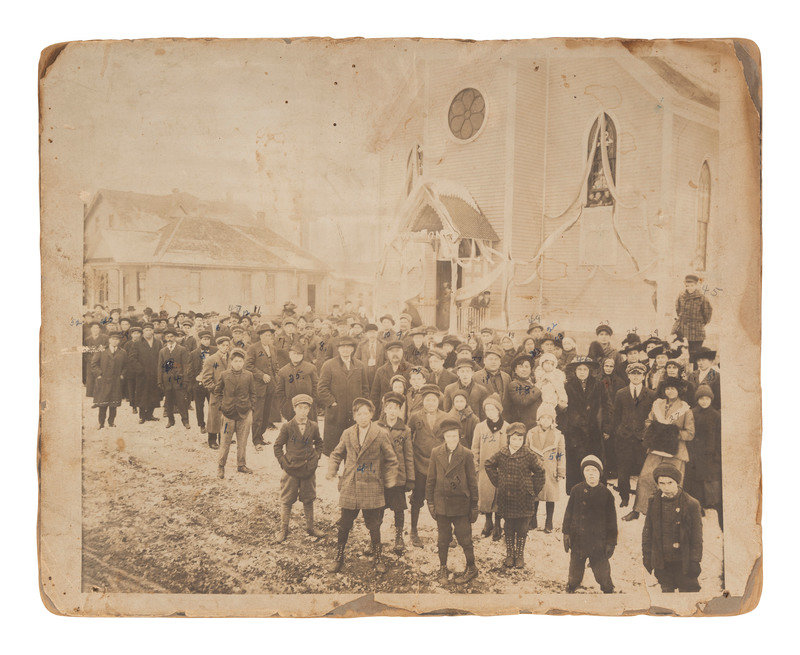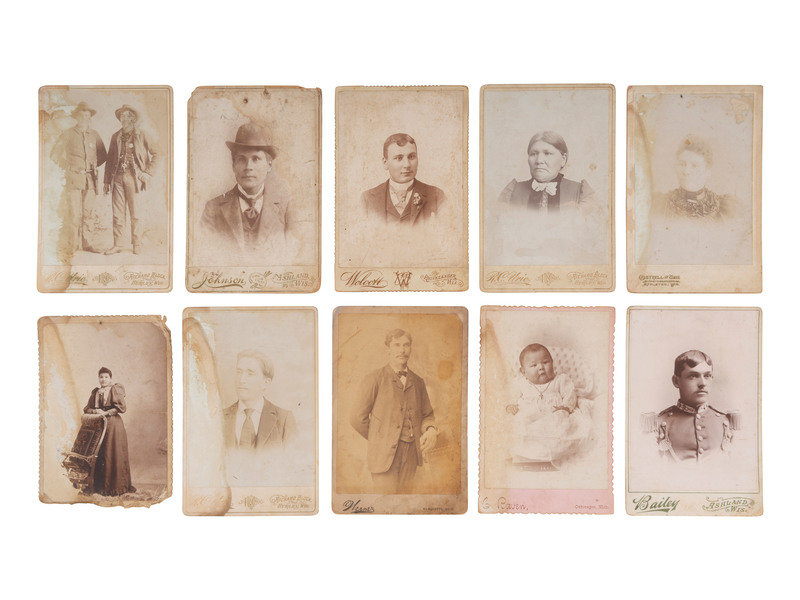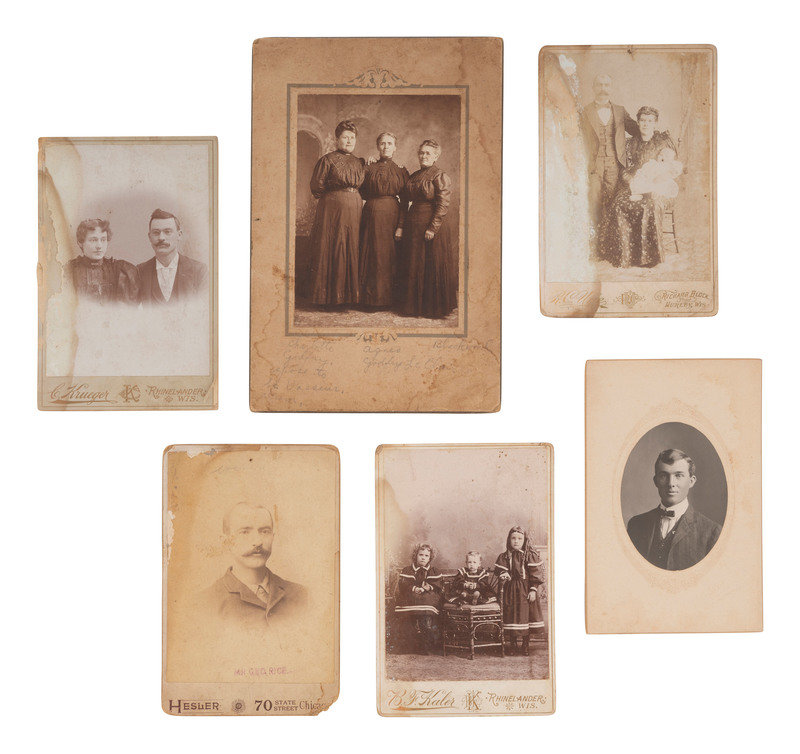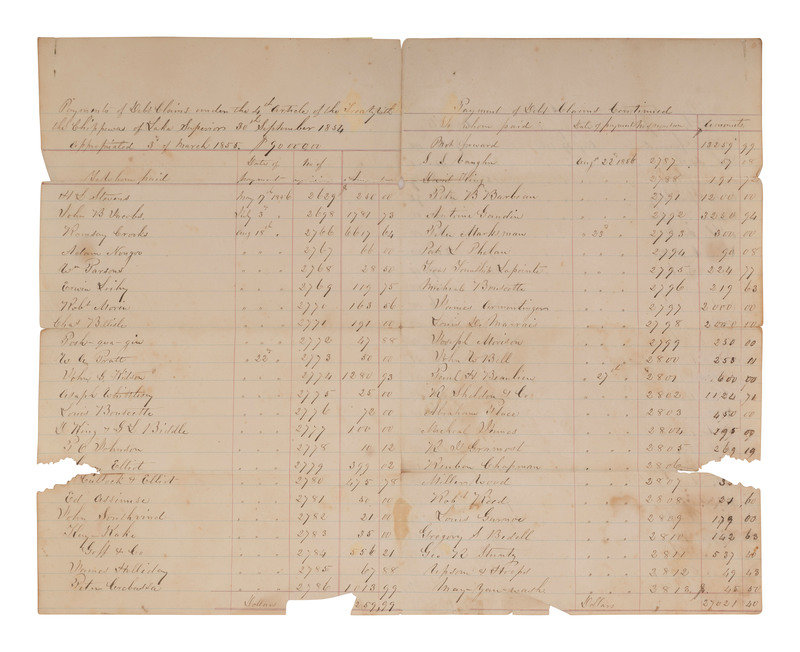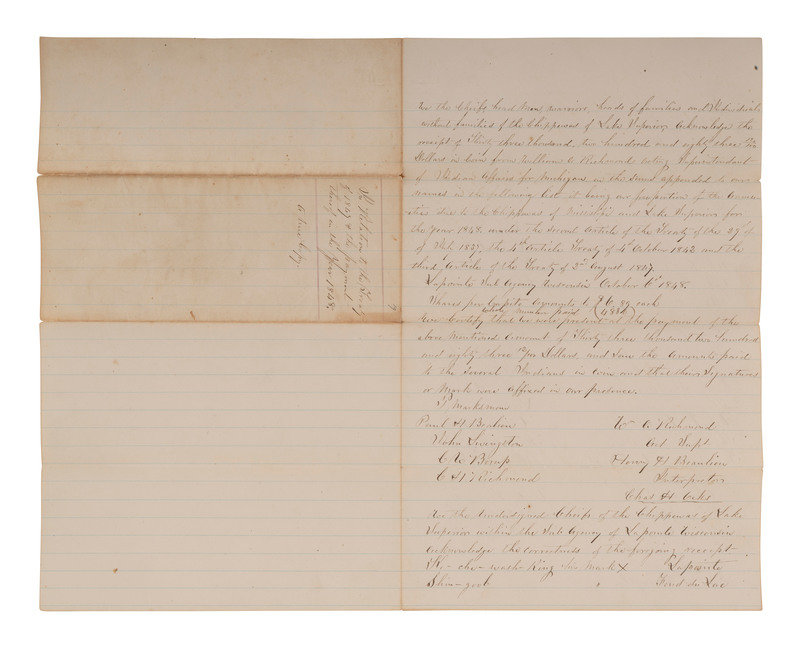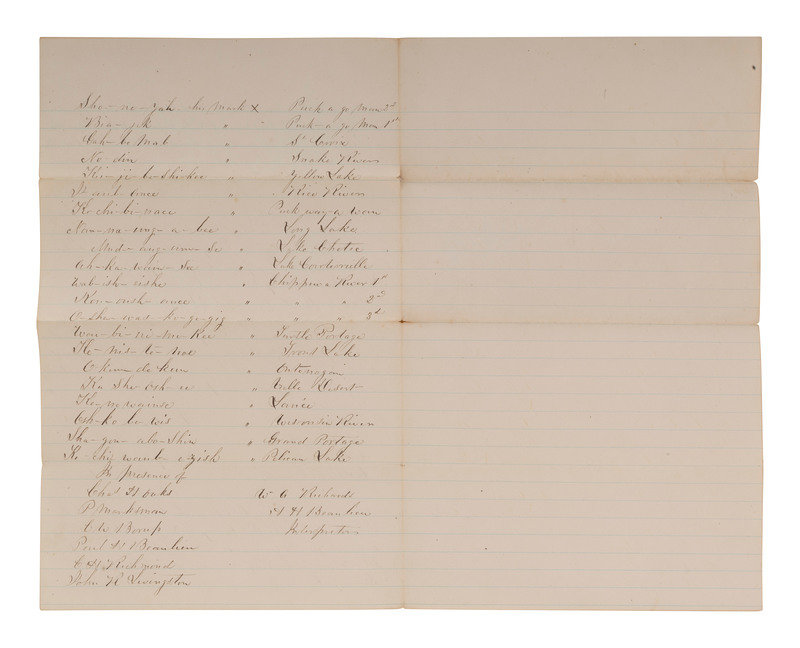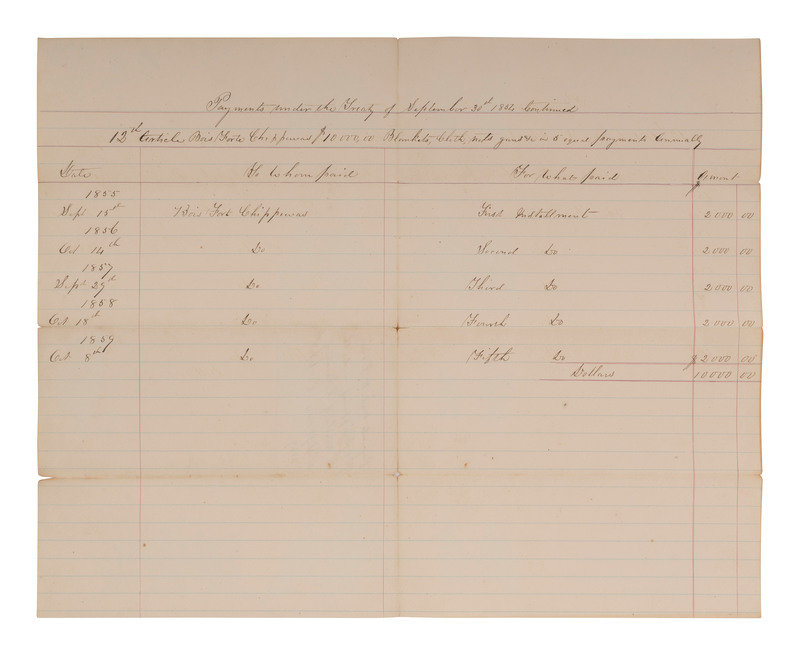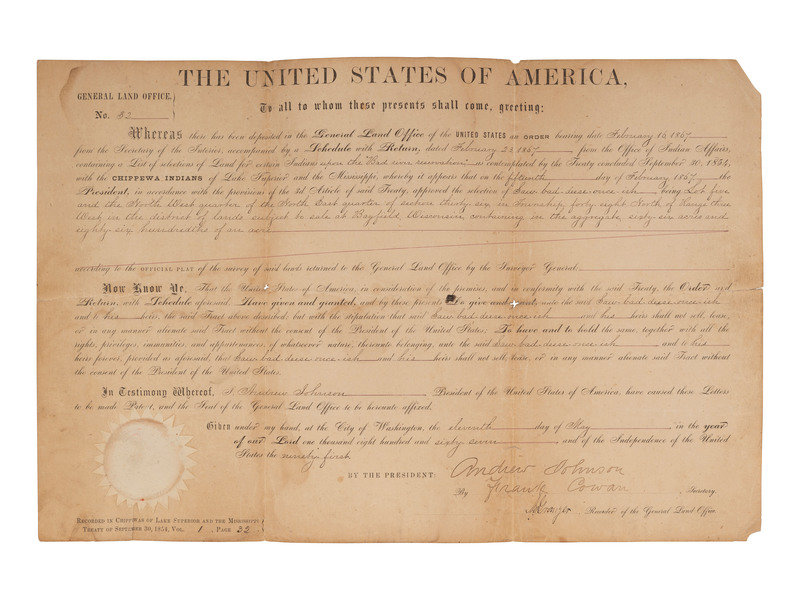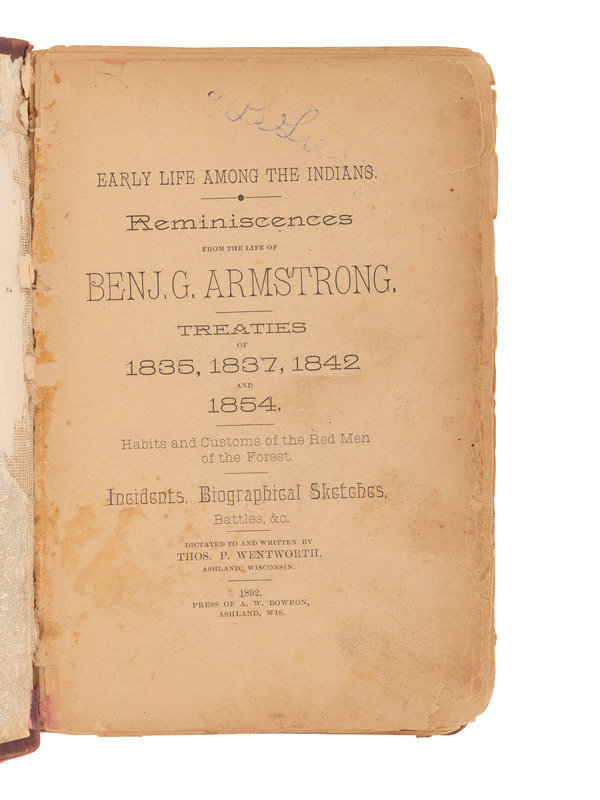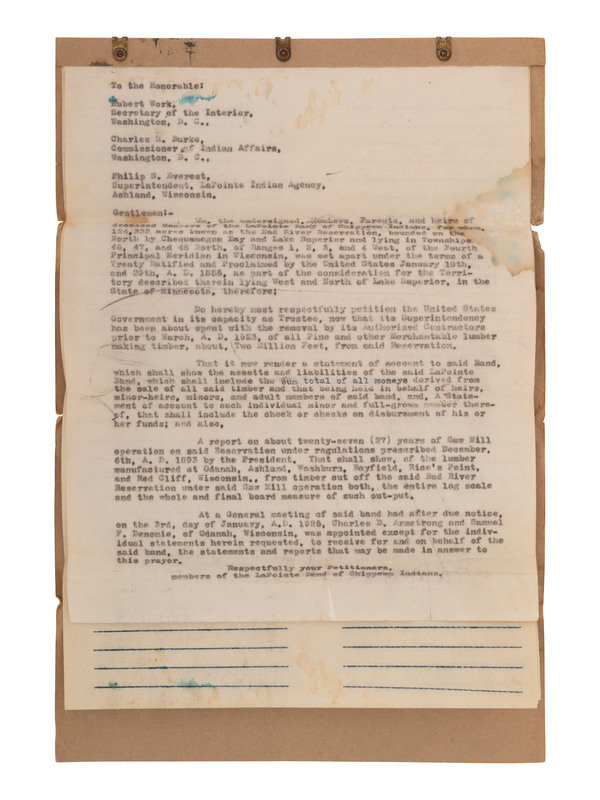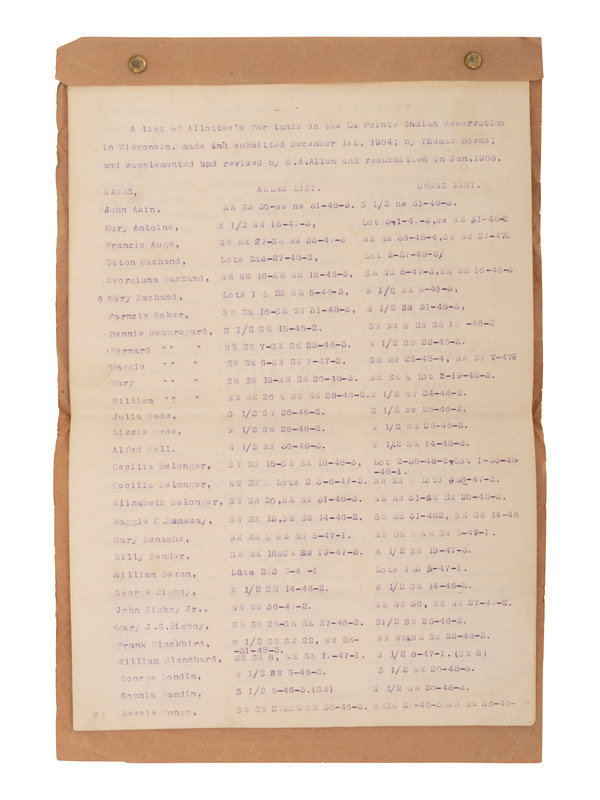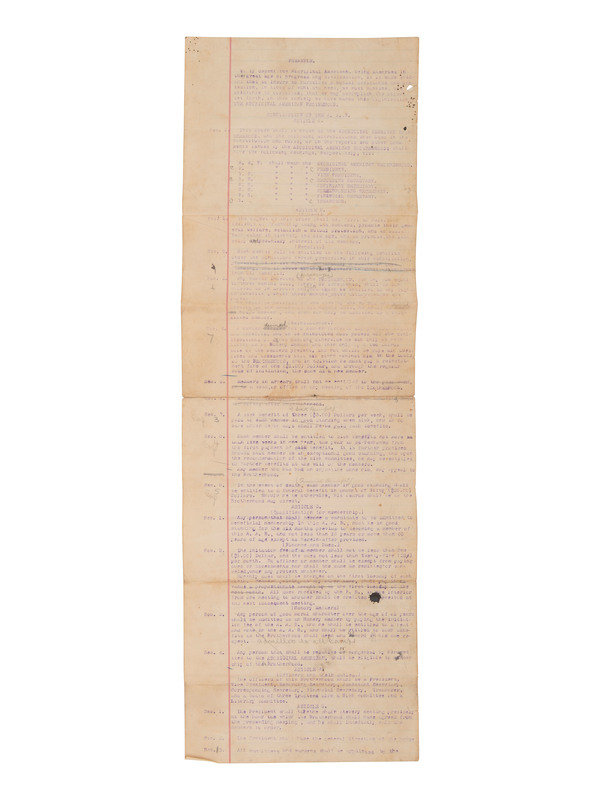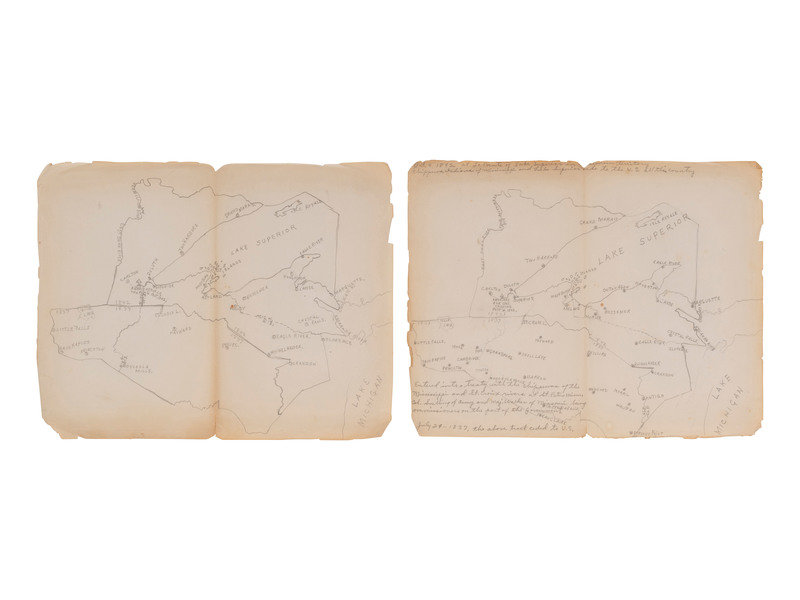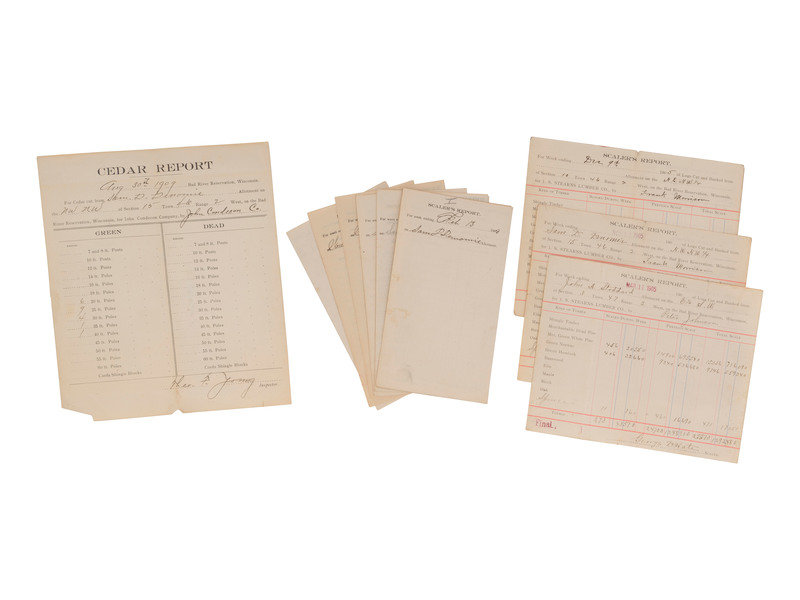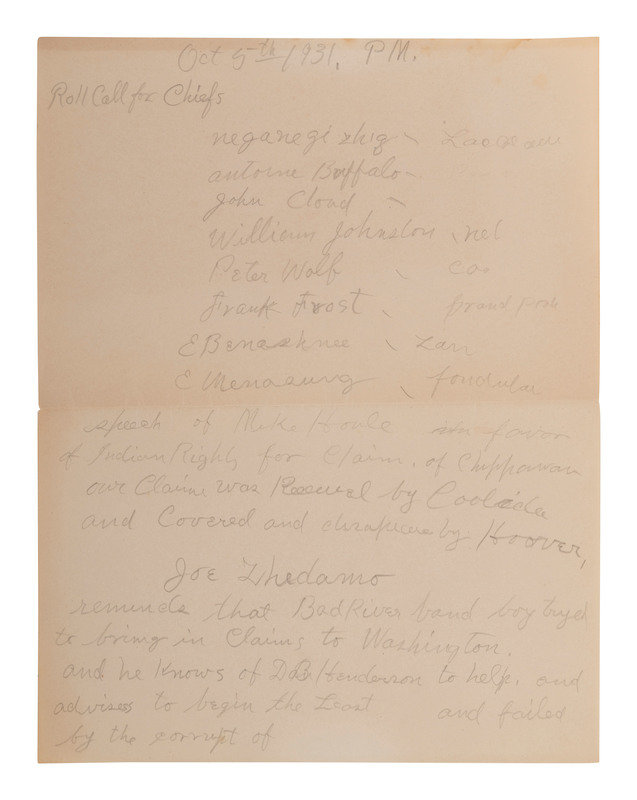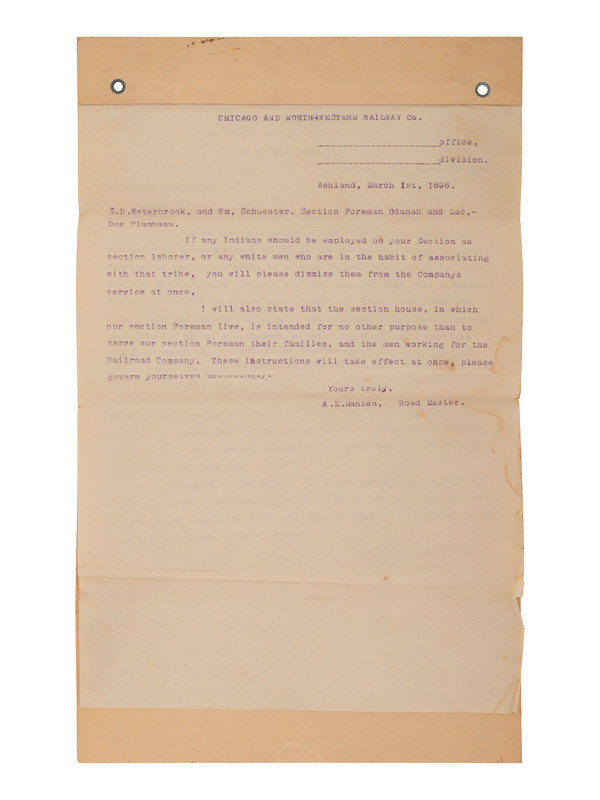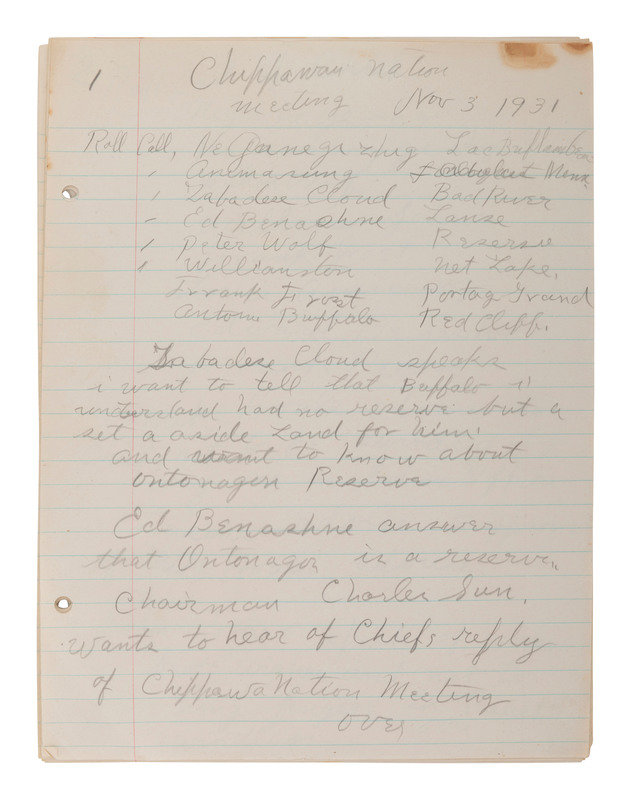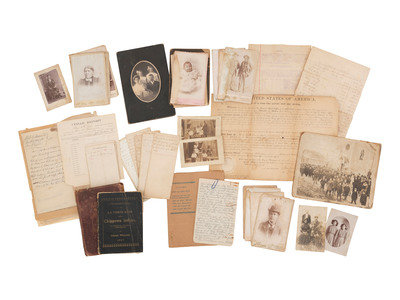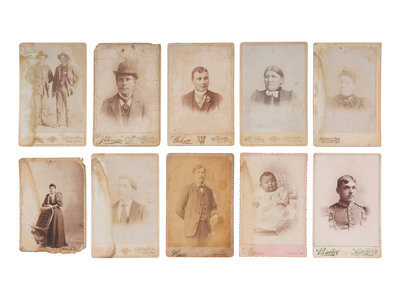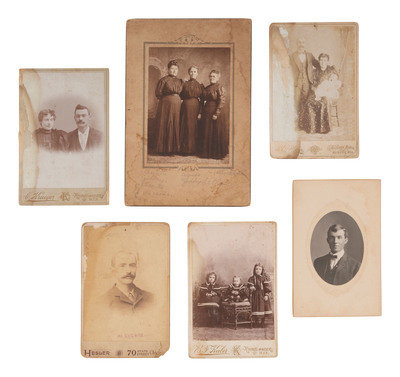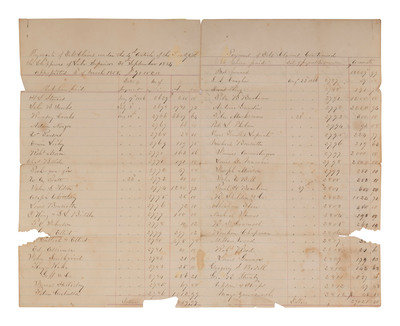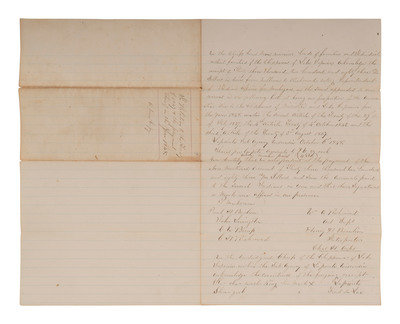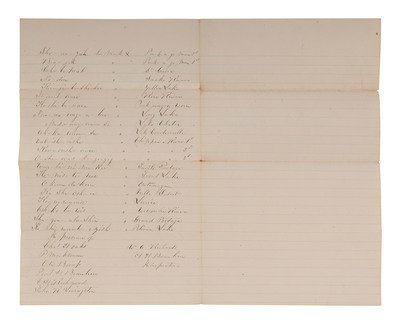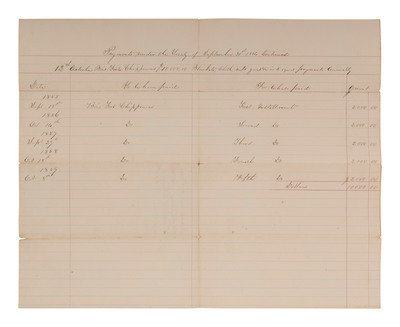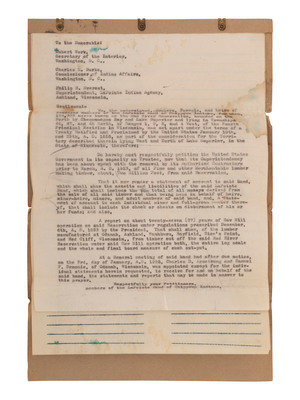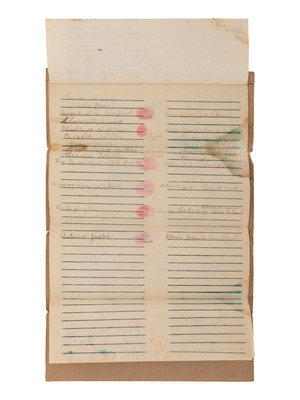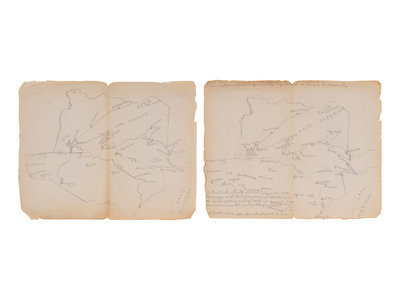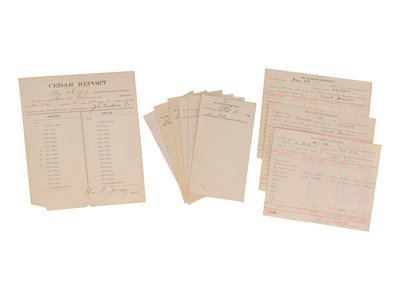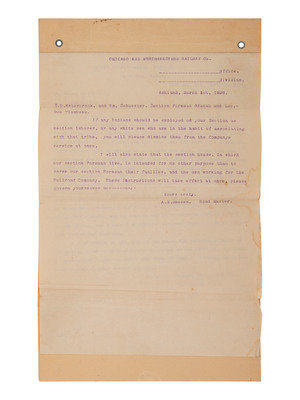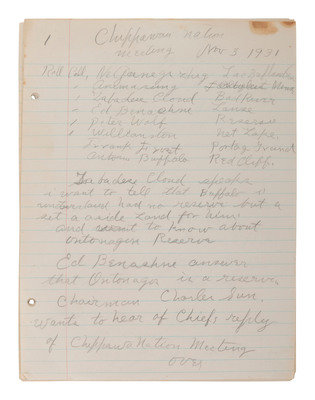[NATIVE AMERICAN]. ARMSTRONG, Charles D. (1866-1931). Papers of Charles D. Armstrong of the Bad River Band of the Lake Superior Tribe of Chippewa Indians, including letters, documents, maps, and photographs.
Sale 1192 - American Historical Ephemera & Photography
Lots 1-294
Jun 15, 2023
10:00AM ET
Lots 295-567
Jun 16, 2023
10:00AM ET
Live / Cincinnati
Estimate
$5,000 -
$7,000
Sold for $10,080
Sold prices are inclusive of Buyer’s Premium
Lot Description
[NATIVE AMERICAN]. ARMSTRONG, Charles D. (1866-1931). Papers of Charles D. Armstrong of the Bad River Band of the Lake Superior Tribe of Chippewa Indians, including letters, documents, maps, and photographs.
Archive of more than 200 items spanning ca 1835-1940s (bulk 1900-1930s) related to the Bad River Indian Tribe, including the following: early photography; documents related to treaty payments and allotments; documents related to timber cut from reservation land; documents associated with the organization of "The Aboriginal American Brotherhood"; documents related to tribal business with the Chicago and Northwestern Railway, J.S. Sterns Lumber Co., and the Ashland Boom and Canal Co.; notes from meetings of tribal bands; roll of tribal members; maps; correspondence associated with Charles D. Armstrong and advocacy efforts on behalf of the tribe; miscellaneous publications and pamphlets associated with Native American interests; copies of the Congressional Record; and more. Provenance: By descent from Charles D. Armstrong to his wife Katherine Poupart Armstrong (1868-1947), to their daughter Pansy Vanancia Armstrong Pavasil (1907- ? ), to current consignor, the daughter of Pansy Vanancia Armstrong Pavasil.
AN IMPORTANT ARCHIVE DESCENDED THROUGH ONE OF THE BAD RIVER TRIBE'S MOST PROMINENT FAMILIES
The archive offered here represents, in part, Bad River tribal efforts to resist government and corporate exploitation, and to ensure that the tribe was fairly compensated for the natural resources utilized on their land. One of the earliest documents in the archive relates to the Treaty of 1847, and is docketed "In Relation to the treaty of 1847 & the payment thereof in the year 1848. / A true copy." This document lists more than 20 Chiefs of the Chippewa of Lake Superior within the Sub Agency of LaPointe Wisconsin who acknowledge the receipt of $33,283 in coin from the Superintendent of Indian Affairs for Michigan, being annuities owed for the year 1848. Other items of note include: a land grant secretarially signed by President Andrew Johnson conveying ownership of a tract of land on the Bad River Reservation to "Saw-bad-deese-once-ish, 11 May 1867"; a manuscript on United States Indian Service letterhead notifying Charles Armstrong "not to come on the Bad River Reservation or suffer the penalities of the law that may follow," 26 February 1896; a document pertaining to the Chicago and North Western System Railway and the dismissal of any Indians employed by the company or or any whites who associate with Indians; a list of "Allottee's for the lands on the La Pointe Indian Reservation in Wisconsin, made and submitted Deember 1st, 1904...and supplemented and revised...in Jan, 1908" (15pp); a typed document "Proceedings of a council of the La Pointe Band. Held December. 10, 1908. creation then, A Business Coucil Committee"; a group of 13 erly 1900s "Scaler's Reports" housed in an envelope identified to "papers of Sam D. Denomie and Sophia M. Blatchford"; "Constitution of the A.A.B.," an undated typed document outlining the constitution of a society to be named "The Aboriginal American Brotherhood," including requirements for membership and benefits; a group of 2 hand-drawn pencil maps, likely early 20th-century, showing lands ceded to the US under terms of 1837 and 1842 treaties; a petition submitted to the Secretary of the Interior, Commissioner of Indian Affairs, and Superintendent, LaPointe Indian Agency by members of the LaPointe band of Chipewa Indians for a detailed statement of accounts of the sum total of monies derived from the sale of timber and saw mill operations at their reservation, signed by members of the tribe, including thumbprints, ca 1925; meeting notes from a meeting of the Chippewa Nation with discussion pertaining to relations with whites and hunting and fishing rights, 3 November 1931 (19pp); and a large amount of documents and correspondence, some late 19th-century but mostly early 20th century, related to Charles Armstrong, timber, and more generally to the Bad River Tribe.
[With:] Photography spanning the last quarter of the 19th century to the mid-1900s, the archive includes 16 cabinet cards, 5 mounted photographs, 10 real photo postcards, 17 snapshots, and 22 negatives. These photographs demonstrate the policies of assimilation that affected the Ojibwe and the extent to which the Bad River Tribe had assimilated into European-American culture. Photography highlights include: an 8 x 10 in. mounted photograph identified by consignor as a Methodist Church in "Old Odanah" featuring the Reverend T.C. Thomas with his congregation, verso with the names of 54 individuals corresponding to numbers hand-marked on the front of the image; a mounted photograph of Charles D. Armstrong with his wife Katherine Poupart Armstrong and their children; a mounted photograph of an unidentified Native American male, taken at Carlisle, PA; a cabinet card of a young man in uniform identified on verso as "Charles D. Armstrong in his Ashland City Band uniform"; a cabinet card of an older woman identfied on verso as "Mrs. Marie Poupart, Lac du Flambeau Wisconsin"; a cabinet card of a young man identified on verso as "Edward Poupart Lac Du Flambeau Wis"; and a cabinet card of two young men with police badges and clubs, identified on verso as "Henry St. Germain" and "Charley Poupart."
[Also with:] Early Life Among the Indians. Reminiscences from the Life of Benj. G. Armstrong. Treaties of 1835, 1837, 1842 and 1854. Habits and Customs of the Red Men of the Forest. Incidents Biographical Sketches, battles, & Co. Ashland, Wisconsin: Press of A.W. Bowron, 1892. Inscribed in pencil with the name "Go-dosh-in-di-moo-we-ya." (Heavy wear to cover and spine, loose binding.) -- Proceedings of the La Pointe Band of Chippewa Indians, in General Council Assembled at Odanah, Wisconsin. 1907.
Charles Douglas Armstrong was the son of Benjamin Greene Armstrong (1820-1900) and Charlotte M. Madwagwan (Charlotte Buffalo, 1832-1882), and the grandson of Chief Buffalo (Kechewaishke), the principal chief of the Lake Superior Chippewa. Chief Buffalo played an important role in mid-19th century tribal politics and in navigating the tribe into a treaty relationship with the United States government. Significantly, Chief Buffalo was instrumental in resisting efforts to remove the Ojibwa to western areas and secured permanent Indian reservations for his people near Lake Superior in present-day Wisconsin. Benjamin Armstrong, who was one of the earliest non-native settlers in Wisconsin, had lived among the Indians of northern Wisconsin and was a skilled interpreter. He accompanied Chief Buffalo in 1852 to Washington, D.C. and following an audience with President Millard Fillmore, successfully fought against cancellation of the Treaty of 1842. It seems Charles D. Armstrong followed in the footsteps of his father and grandfather, participating in advocacy efforts on behalf of his tribe. Charles was a member of the Tribal Business Council, and he testified multiple times on behalf of his people, including in 1909 Senate Committee on Indian Affairs hearings and before the United States Congress during 1919 hearings on "Conditions on the Bad River Reservation, Wis." While many Bad River Tribe members worked to promote the best interests of their tribe, the Armstrong family had a particularly important role in tribal history.
This lot is located in Cincinnati.
Property from the Collection of D. Zompolas, Grand-daughter of Chas. D. Armstrong
Condition Report
The physical condition of lots in our auctions can vary due to
age, normal wear and tear, previous damage, and
restoration/repair. All lots are sold "AS IS," in the condition
they are in at the time of the auction, and we and the seller make
no representation or warranty and assume no liability of any kind
as to a lot's condition. Any reference to condition in a catalogue
description or a condition report shall not amount to a full
accounting of condition. Condition reports prepared by Hindman
staff are provided as a convenience and may be requested from the
Department prior to bidding.
The absence of a posted condition report on the Hindman website or
in our catalogues should not be interpreted as commentary on an
item's condition. Prospective buyers are responsible for
inspecting a lot or sending their agent or conservator to inspect
the lot on their behalf, and for ensuring that they have
requested, received and understood any condition report provided
by Hindman.
Please email [email protected] for any additional information or questions you may have regarding this lot.

